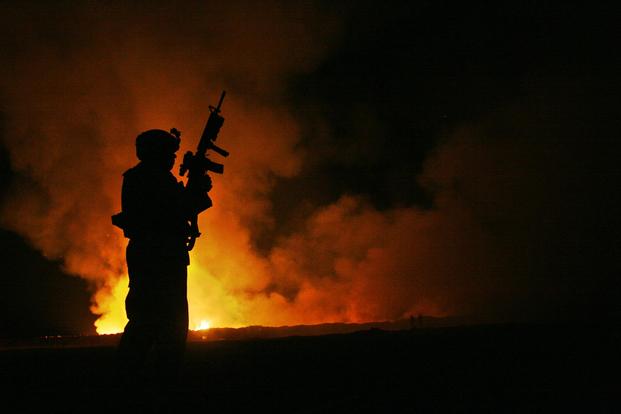Researchers with the influential National Academy of Medicine have recommended that the Defense and Veterans Affairs departments track troops' exposure to environmental toxins and monitor their -- and their offspring's -- health to better understand the risks and consequences of military deployment.
In a report released Nov. 28 by the National Academies of Sciences, Engineering and Medicine, a panel of 16 scientists said they could not definitively link health issues in some 1990-1991 Gulf War and post-9/11 veterans and their families to environmental exposures, but they recommended the government and other institutions establish a health monitoring and research program to determine what health effects, if any, military deployments have on the veterans and future generations.
Nearly 700,000 service members deployed to the Persian Gulf region during Operations Desert Shield and Desert Storm, and 2.7 million have been stationed in or fought in Iraq, Afghanistan and elsewhere since Sept. 11, 2001. Many of these veterans may have been exposed to "potentially hazardous agents and situations," the report noted, such as pesticides, solvents, chemicals and biological agents, vaccines, burn pit and oil well fire smoke, dust and depleted uranium.
To determine whether exposure to any of these substances is responsible for illnesses found in some of these veterans and their family members, the panel looked at more than 80,000 publications on reproductive and genetic effects of environmental exposures, mostly research on civilian populations exposed to the same substances, or animal studies, because research specific to military exposures is scant.
The committee largely concluded that there is insufficient evidence in the existing literature to link reproductive conditions or health problems in veterans' offspring with the most common contaminants seen on the battlefield.
Members did note, however, that there is limited or suggestive evidence that sulfur mustard may have a negative effect on men's reproduction, that the bacterial infection leishmaniasis may negatively affect pregnancy outcomes, and that chromium -- a chemical used in paint and as an anti-corrosive -- can negatively impact men's reproduction, pregnancy outcomes and child development.
Also, the committee found sufficient evidence of an association between prenatal exposure to some pesticides and neurodevelopmental effects; prenatal exposure to particulate matter and adverse pregnancy outcomes, such as low birth weight and preterm birth; and prenatal exposure to benzene and childhood leukemia.
A health monitoring and research program would help broaden the understanding of deployment-related exposures and the long-term effects on generations, according to the report.
Establishing such a program would require "substantial resources, long-term commitment by the Defense and Veterans Affairs departments and other governmental organizations and considerable engagement by past, current, and future veterans and their families," but the contribution to science would be significant, said Dr. Kenneth Ramos, panel chair and executive director of the Center for Applied Genetics and Genomic Medicine at the University of Arizona.
"The results that arise from studying generational effects will ultimately be rewarded with new knowledge of veterans' exposures, their reproductive health, and the health of their children and grandchildren. Importantly, the new understanding derived from these investments will be relevant to the health of all Americans now and for future generations."
By direction of Congress in 1998, the VA contracted with NASEM to conduct systematic reviews of research on associations between illnesses and serving in the Persian Gulf. The National Academies have created 11 reports on the subject, including Gulf War and Health, Generational Health Effects of Serving in the Gulf War.
In November, the National Academies also recommended that the VA study the generational exposure to dioxin in children of Vietnam veterans exposed to Agent Orange.
-- Patricia Kime can be reached at patriciankime@gmail.com. Follow her on Twitter @patriciakime.












